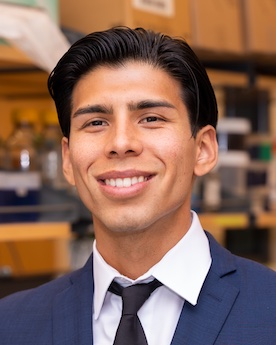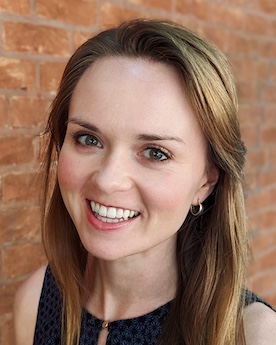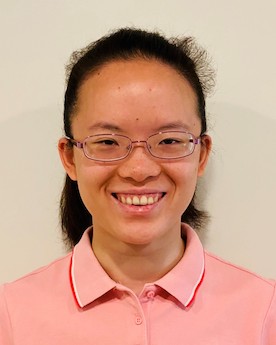
Whitehead Institute for Biomedical Research
Appointed in 1984
Read more
Whitehead Institute for Biomedical Research
Appointed in 1984

Vanderbilt University Medical Center
Appointed in 2023
Read more
Vanderbilt University Medical Center
Appointed in 2023
Clostridioides difficile infection (CDI) is the leading cause of hospital-acquired and antibiotic-associated intestinal infections. However, we do not currently have a clear understanding of CDI pathogenesis, which impedes the development of additional therapeutic strategies. Dr. Martin Douglass will investigate how CDI overcomes the human microbiota and immune system in Dr. Eric Skaar’s lab at Vanderbilt University Medical Center. Dr. Douglass will examine how CDI competes for nutrients with the microbiota and immune system. Furthermore, Dr. Douglass will identify which CD genes are required for host colonization and persistence. These studies may provide insight into novel therapeutic targets for treating CDI.
As a graduate student in Dr. M. Stephen Trent’s lab at the University of Georgia, Douglass examined the outer membrane of Gram-negative bacteria. Dr. Douglass discovered novel proteins that are required for the transport of lipids to the outer membrane. These studies provide potential therapeutic targets for novel antibiotics and provide Douglass with a solid foundation for interrogating new targets in CDI.

University of California, Berkeley
Appointed in 2007
Read more
University of California, Berkeley
Appointed in 2007


Stanford University
Appointed in 1964

Fred Hutchinson Cancer Center
Appointed in 2013
Read more
Fred Hutchinson Cancer Center
Appointed in 2013
My research focuses on the evolutionary diversity of centromeric architectures. Faithful chromosome segregation in all eukaryotes relies on centromeres, the chromosomal sites that recruit the kinetochore protein complex to mediate spindle attachment during cell division. Yet, despite this essential function centromeres are remarkably diverse. Most chromosomes are monocentric i.e., kinetochore assembly is restricted to a defined chromosomal region. In contrast, holocentromeres have kinetochores attached along the entire length of chromosomes. Holocentric chromosomes have evolved multiple times independently from monocentric ancestors. Yet, despite their dramatically different centromeric architectures, the transition to holocentric chromosomes has remained enigmatic.
I performed a computational survey for centromere and kinetochore components in mono- and holocentric insect orders. This study revealed the unexpected finding that the centromere specific histone variant, CenH3 – known to be essential for centromere function in most eukaryotes – was lost on all four lineages that are associated with independent transitions from mono- to holocentric chromosomes. Expanding my analyses to other kinetochore components I found that homologs of many inner kinetochore proteins are still present, suggesting that holocentric insects utilize alternative ways of initiating kinetochore assembly on chromatin. Currently I am in the process of determining the CenH3-independent kinetochore assembly pathway as well as the molecular architecture of the insect holocentromere.


Stanford University
Appointed in 2008
My current research involves analysis of the cellular response to replication fork stress.
After finishing my undergraduate degree at the University of Leeds in the UK, still pretty clueless as to what I wanted to study, I worked in the lab of E. Peter Geiduschek at the University of California, San Diego, as a research technician. There, I developed a fascination with DNA metabolism. I continued pursing this interest ¬†by studying DNA repair in the lab of Steve Jackson at Cambridge University for my doctoral studies, and am now studying DNA replication. I greatly enjoy the challenge of independent academic research but also the fact that it is a very social endeavor. When I’m not in the lab, I’m usually hiking and camping in California or enjoying its excellent food and beverages.

Fred Hutchinson Cancer Center
Appointed in 1997
Read more
Fred Hutchinson Cancer Center
Appointed in 1997


University of Pennsylvania
Appointed in 1991

National Institutes of Health
Appointed in 1996
Read more
National Institutes of Health
Appointed in 1996

Johns Hopkins University /
University of Michigan
Appointed in 1973
Read more
Johns Hopkins University / University of Michigan
Appointed in 1973

Washington University in St. Louis
Appointed in 1997
Read more
Washington University in St. Louis
Appointed in 1997

Massachusetts General Hospital
Appointed in 2002
Read more
Massachusetts General Hospital
Appointed in 2002

Stanford University School of Medicine
Appointed in 2003
Read more
Stanford University School of Medicine
Appointed in 2003

MRC Center, University Medical School, England
Appointed in 1977
Read more
MRC Center, University Medical School, England
Appointed in 1977

Washington University in St. Louis
Appointed in 1990
Read more
Washington University in St. Louis
Appointed in 1990


Harvard University Medical School
Appointed in 2017
The 2016 Nobel laureate Dr. Yoshinori Ohsumi remarked, “ Life is an equilibrium state between the synthesis and degradation of proteins”. My research focuses on Autophagy, a process whereby proteins are marked for destruction in cells by the lysosome. I became interested in autophagy during my PhD in Dr. Jim Haber’s lab at Brandeis University, and have been hooked on it ever since!_x000D_
_x000D_
The autophagy-lysosome system targets the degradation of a specific cohort of proteins via “selective autophagy”. The dysfunction of this phenomenon has been linked to a myriad of human disorders. We have only scratched the surface of the known targets of this fascinating biological process. Under the guidance of my mentors, the aim of my research will be to comprehensively catalog the list of selective autophagy substrates by employing quantitative mass spectrometry of the autophagy-lysosome system. An overarching goal of my research is to obtain knowledge of the selective autophagic targets in cancer, which may present opportunities for the specific targeting of this process_x000D_
_x000D_
I grew up in New Delhi, India. After completing my undergrad program in Biotechnology at the Vellore Institute of Technology in South India, I moved to the U.S. (Brandeis university, MA) for graduate studies. In my spare time, I am whittling down all of the 48 four thousand feet peaks in the White Mountain range while assiduously taking guitar lessons in the hope of one day playing lead guitar for a major rock band.

University of California, San Francisco
Appointed in 1989
Read more
University of California, San Francisco
Appointed in 1989


Rockefeller University
Appointed in 1975


University of Wisconsin, Madison
Appointed in 1993


Stanford University
Appointed in 1964

Massachusetts Institute of Technology
Appointed in 1987
Read more
Massachusetts Institute of Technology
Appointed in 1987

MRC Center, University Medical School, England
Appointed in 1982
Read more
MRC Center, University Medical School, England
Appointed in 1982

International Laboratory of Genetics and Biophysics, Italy
Appointed in 1965
Read more
International Laboratory of Genetics and Biophysics, Italy
Appointed in 1965

Albert Einstein College of Medicine
Appointed in 1970
Read more
Albert Einstein College of Medicine
Appointed in 1970


Stanford University
Appointed in 1973

Massachusetts Institute of Technology
Appointed in 1987
Read more
Massachusetts Institute of Technology
Appointed in 1987


Stanford University
Appointed in 1978

California Institute of Technology
Appointed in 1971
Read more
California Institute of Technology
Appointed in 1971

Brigham and Women's Hospital
Appointed in 2009
Read more
Brigham and Women's Hospital
Appointed in 2009


Stanford University
Appointed in 2009
My work in Gerald Crabtree’s laboratory focuses on elucidating how structural changes in the packaging of DNA, otherwise known as chromatin, contributes to the acquisition of cellular identity. Specifically, I am investigating the mechanism by which subunit switches in an ATP-dependent chromatin remodeling complex promote the development and maturation of neural progenitor cells into fully functional neurons.
I have been driven throughout my training by a passion for discovery and appreciation for a scientific, analytical approach to problem-solving. I majored in biology at Swarthmore College and earned my PhD in the Neuroscience Program at the University of California, San Francisco (UCSF). My thesis in Arnold Kriegstein’s laboratory at the UCSF Institute for Regeneration Medicine focused on elucidating the mechanism by which newborn neurons migrate from their places of origin to specific cortical regions, where they integrate into the brain’s circuitry.  During my postdoctoral fellowship, I have expanded my studies to include genomics, proteomics and biochemistry to probe the role chromatin structure plays during neural development.   I aspire to use my training to have a broad impact on the global scientific community, and influence the incorporation of scientific innovation into society.

Johns Hopkins University School of Medicine
Appointed in 2023
Read more
Johns Hopkins University School of Medicine
Appointed in 2023
Sleep disorders are common and negatively impact our quality of life and biological health. Yet, how the brain encodes the need for restorative sleep is poorly understood. Dr. Leah Elias will investigate the cellular circuits and molecular signals that encode sleep pressure in Dr. Seth Blackshaw’s lab at Johns Hopkins University School of Medicine. Using single nucleus RNA sequencing, Dr. Elias has identified a cluster of neurons that are activated by sleep deprivation. Furthermore, she has identified candidate genes that are differentially regulated in response to sleep deprivation. She will leverage these findings to mechanistically dissect sleep signals in the brain at the cellular and molecular levels. Dr. Elias’ research has important implications for the basic biology of sleep and may reveal novel therapeutic targets for sleep and metabolic disorders.
As a PhD student in Dr. Ishmail Abdus-Saboor‘s lab at the University of Pennsylvania, Dr. Elias studied the neural circuitry controlling social touch. Specifically, she identified a new pathway that connects social touch in the skin to reward circuits in the brain. With this background in neural circuitry, Dr. Elias will now investigate how the need for sleep is encoded in the brain.

University of Wisconsin, Madison
Appointed in 1990
Read more
University of Wisconsin, Madison
Appointed in 1990


Yale University
Appointed in 1987


National Cancer Institute
Appointed in 1979


University of Virginia
Appointed in 2017
Organisms exhibit diverse strategies to survive environments that vary in space and time. In temperate climates, environmental cues are used to anticipate the onset of unfavorable seasons. One of the most reliable indicators of season is photoperiod: the length of light and dark periods within a 24-hour day. Insects exhibit a spectacular array of responses to changes in season. For example, aphids develop sexually reproducing morphs in the fall, moths and lacewings develop unique seasonal patterns and colors, monarch butterflies undergo seasonal migrations, and hundreds of species, including the fruit fly Drosophila melanogaster, are able to suspend development or reproduction until more favorable conditions return. Despite nearly a century of research on insect seasonality and photoperiodism, the genetic pathways used to make these ecologically crucial transitions remain unknown. The abundance of genetic and genomic resources for Drosophila makes it an ideal study system for this question._x000D_
_x000D_
My research uses custom-built environmental chambers, field studies in an experimental orchard, and novel genetic mapping techniques to dissect the genetic basis of photoperiodism and seasonal responses in Drosophila. Understanding how insects detect photoperiod will inform our understanding of economically and biomedically important insects and offer predictions about how insects may adapt to ongoing anthropogenic climate warming in which temperature, but not photoperiod, is changing.

Harvard University Medical School
Appointed in 2007
Read more
Harvard University Medical School
Appointed in 2007


Rockefeller University
Appointed in 2008
In my research with Elaine Fuchs, I am studying how the primary cilium regulates the function of epidermal stem cells during embryonic development and wound healing.
I was introduced to nature by my grandmother, who instilled in me a sense of awe for living things as we explored the forests near where I grew up in northwestern Pennsylvania, collecting roots, mushrooms and bugs.  My childhood fascination with nature led me to study biology.
I am interested in how cells interact with and respond to their environment.   In my doctoral research, I tried to understand how the microtubule cytoskeleton controlled the ability of cells to regulate focal adhesions, structures that allow a cell to communicate with its environment during cell migration. For my post-doctoral work, I maintained this interest, but also became fascinated with how stem cells in a tissue are able to “sense” the environmental developmental signals that lead to proper differentiation — leading me to study the function of the primary cilium in the epidermis. Primary cilia are evolutionarily conserved sensory organelles which act as a cellular antenna, allowing the cell to sample its extracellular environment and process signals that are essential for proper cell growth, development and differentiation.

Salk Institute for Biological Studies
Appointed in 2015
Read more
Salk Institute for Biological Studies
Appointed in 2015


Brandeis University
Appointed in 2019

Harvard University Medical School
Appointed in 1967
Read more
Harvard University Medical School
Appointed in 1967

Whitehead Institute for Biomedical Research
Appointed in 1998
Read more
Whitehead Institute for Biomedical Research
Appointed in 1998


Columbia University
Appointed in 2001

National Institute for Medical Research, England
Appointed in 1973
Read more
National Institute for Medical Research, England
Appointed in 1973

Harvard University
Appointed in 2013
Read more
Harvard University
Appointed in 2013
The goal of my project is to identify and characterize novel signals regulating development. Many of the processes taking place during development are controlled by a handful of well-characterized signaling pathways. This observation has led to the belief that most, if not all, of the major developmental signals are known. However, recent genomics projects have identified numerous uncharacterized genes, several of which encode short secreted peptides. A zebrafish mutant generated in one of these peptides, EndE, has a dramatic developmental phenotype, where the embryo forms little or no heart tissue. This suggests that EndE regulates the specification and/or migration of cardiac precursor cells. I will investigate the role of EndE in cardiac development and identify its receptor (Aim 1). Additionally, I will generate mutants for several other novel secreted peptides and analyze their phenotypes (Aim 2). My project will elucidate the role of a novel regulator of heart formation and identify new developmental signaling molecules.

University of California, San Francisco
Appointed in 2004
Read more
University of California, San Francisco
Appointed in 2004

University of Texas Southwestern Medical Center
Appointed in 1996
Read more
University of Texas Southwestern Medical Center
Appointed in 1996


Karolinska Institutet, Sweden
Appointed in 1962

University of California, San Francisco
Appointed in 2001
Read more
University of California, San Francisco
Appointed in 2001

Washington University School of Medicine
Appointed in 1995
Read more
Washington University School of Medicine
Appointed in 1995

Massachusetts Institute of Technology
Appointed in 2018
Read more
Massachusetts Institute of Technology
Appointed in 2018
Mutations in genes that encode core RNA splicing machinery (such as SF3B1, U2AF1, SRSF2) are frequently associated with hematologic malignancies1–3 (Fig. 1). A number of studies have identified specific splicing defects associated with these mutations4–6, but the impact on gene expression program in these disorders remains poorly understood. Most human transcripts are spliced cotranscriptionally,and revealed previously unknown roles of splicing in regulating transcription7–10. These observations led me to propose that effects of dysregulated splicing on transcription contribute to pathogenesis of cancer. Recently, my new host lab has identified a new regulatory link between splicing and transcription termed “exon-mediated activation of transcription starts” (EMATS)23 (Fiszbein et al.). In brief, they found that inclusion (splicing in) of alternative exons (often found in 5′ UTR) can activate transcription from a proximal upstream alternative promoter (within 1 or 2 kb), showing that expression of such genes is dependent on nearby splicing. However, the precise requirements and mechanistic details are not fully understood. Therefore, I propose to investigate the cis- and trans-acting determinants of EMATS and to use this information to understand the impacts of perturbed splicing on gene expression programs in hematologic malignancies.


Stanford University
Appointed in 2023
c-Myc is a transcription factor and an attractive therapeutic target as it drives the majority of human cancers. However, inhibiting c-Myc at the protein level is difficult, in part due to its intrinsically disordered structure. Dr. Sheng Feng aims to circumvent this problem by inhibiting c-Myc mRNA with small molecules. Dr Feng will use a fragment-based approach using an RNA-biased library that is functionalized to improve affinity for RNA. Dr. Feng will tether fragments that bind to adjacent RNA sites to improve binding affinity and selectivity. These experiments will be conducted in Dr. Eric Kool’s lab at Stanford University. Dr. Feng’s research will explore a new route for inhibiting an important target in oncology and represents a general method for inhibiting other difficult protein targets.
As a graduate student in Dr. Stephen Buchwald’s lab at the Massachusetts Institute of Technology, Feng developed copper hydride-catalyzed bond forming reactions that are highly regio- and stereoselective. Such reactions produce important substructures for pharmaceuticals, agrochemicals, and natural products. Dr. Feng’s background in organic chemistry has prepared her to design and prepare small molecule ligand libraries for targeting c-Myc mRNA.